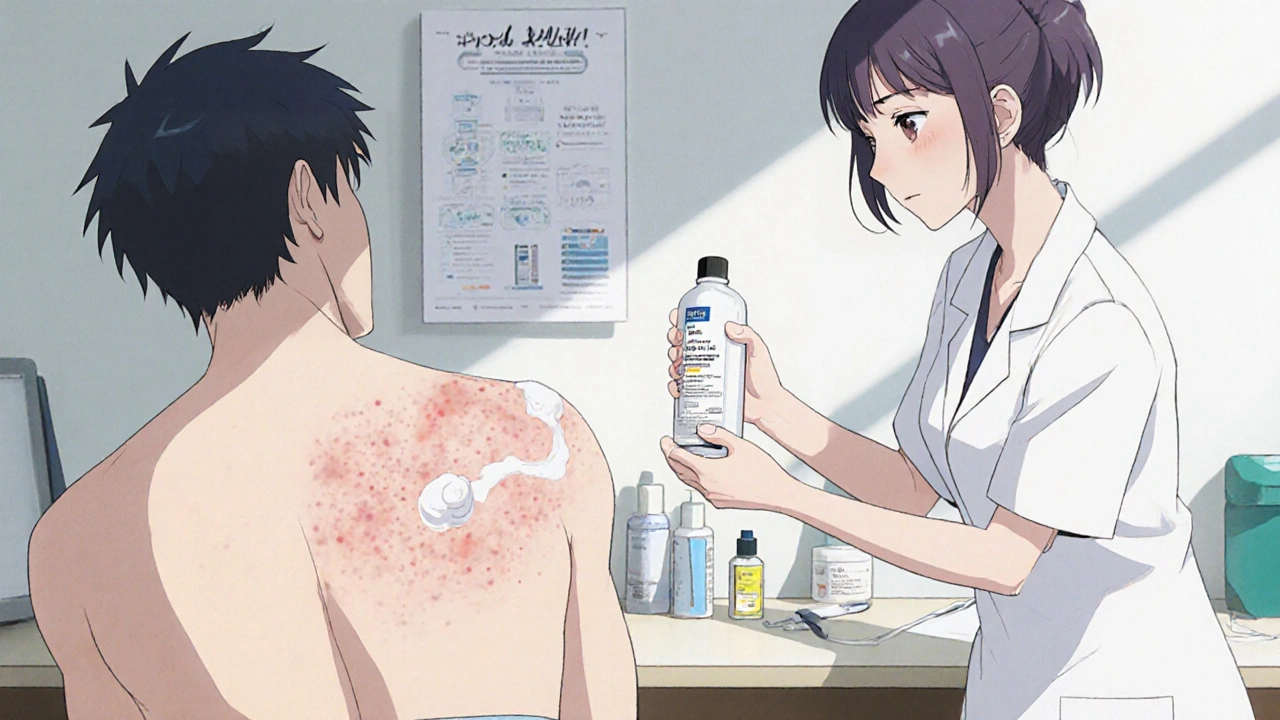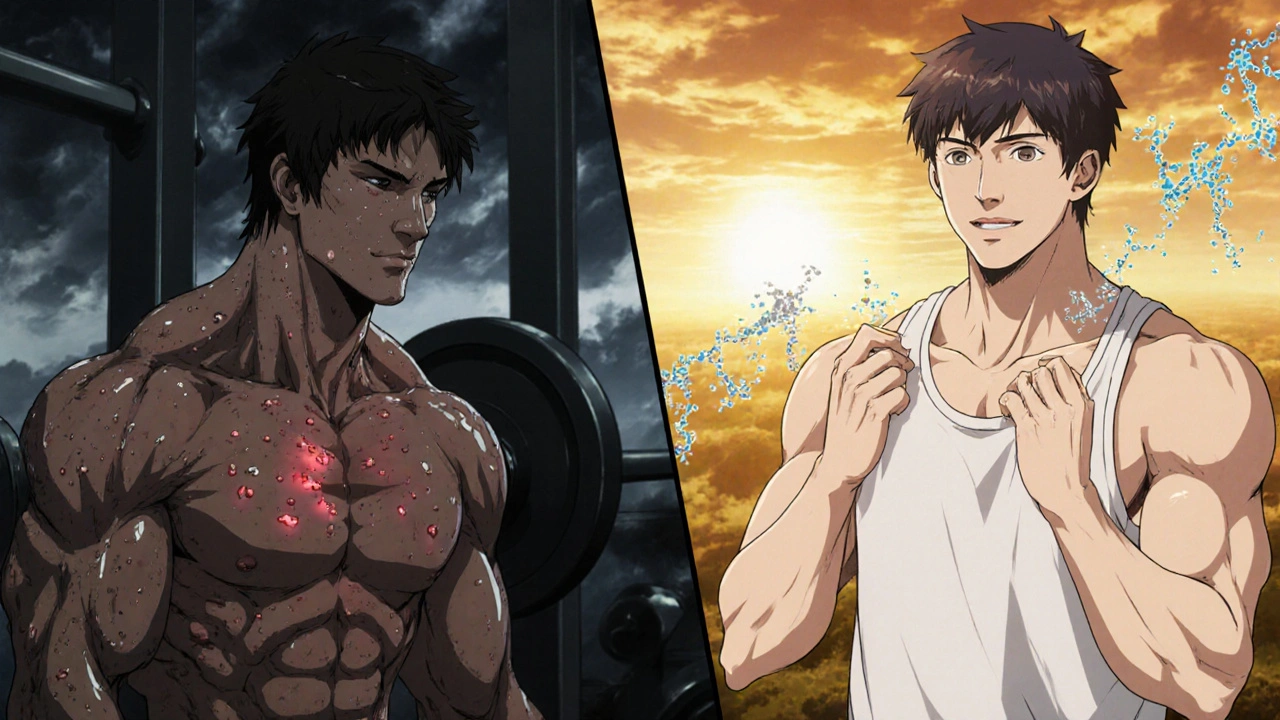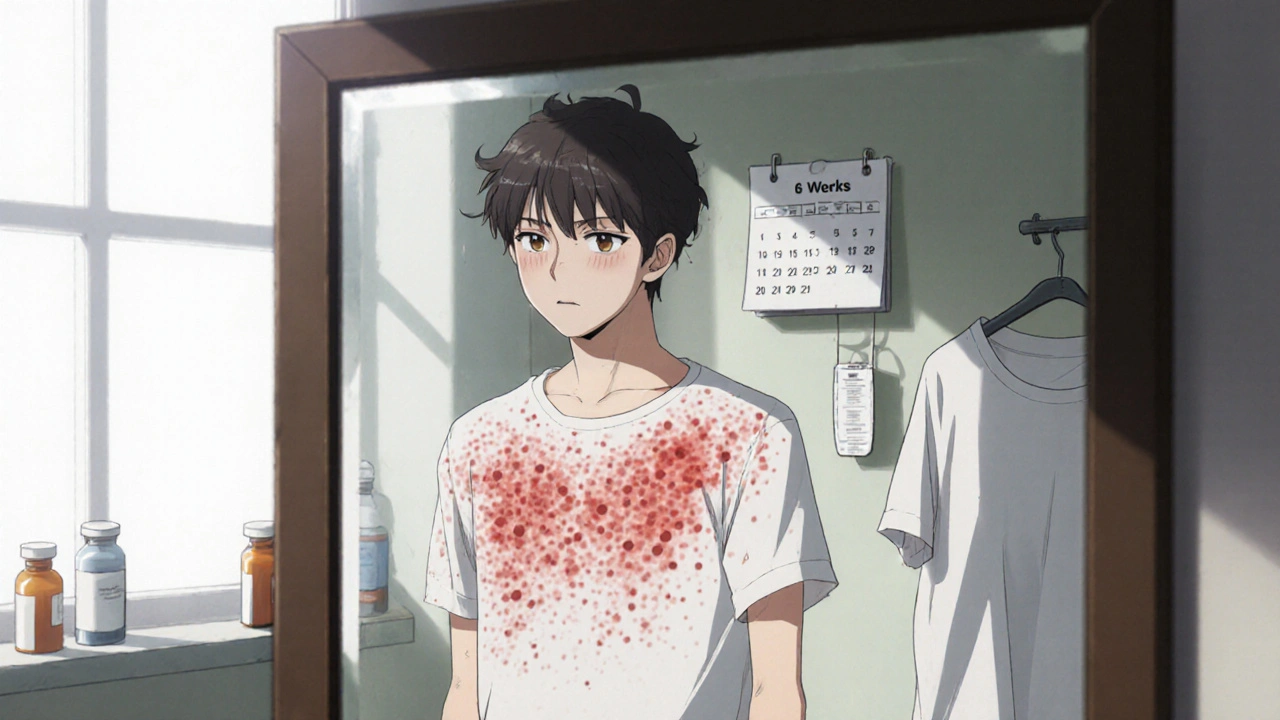Steroid Acne Treatment Guide
Find Your Best Treatment Plan
Based on your steroid type, symptoms, and severity, we'll recommend the most effective approach for your steroid-induced acne.
Your Treatment Plan
Timeline for Improvement
Initial reduction in inflammation and redness
Significant improvement in lesion count
Maximum results with complete resolution of lesions
When you start taking steroids-whether for asthma, an autoimmune condition, or bodybuilding-you don’t expect your skin to turn against you. But for 1 in 5 people on moderate to high doses, that’s exactly what happens. A sudden flood of small, red, uniform bumps appears on the chest, back, or even the face. They don’t respond to your usual acne routine. They don’t go away when you wash more. And they’re not just pimples-they’re a direct reaction to the steroids in your system. This is steroid-induced acne, and it’s more common than most doctors admit.
What Makes Steroid Acne Different From Regular Acne?
Steroid acne doesn’t look like the teenage zits you remember. It’s not messy or scattered. It’s precise. Hundreds of tiny, red, follicular bumps-often all the same size-crop up in waves, mostly on the chest and upper back. The face can be affected too, but the trunk is the main battleground. Unlike regular acne, which has blackheads, whiteheads, and deep cysts mixed together, steroid acne often looks like a uniform rash of papules. In about one-third of cases, it’s not acne at all-it’s Malassezia folliculitis, a fungal infection triggered by steroids that causes itchy, pus-filled bumps without comedones.
The difference isn’t just cosmetic. Regular acne is driven by hormones, oil production, and clogged pores. Steroid acne is a direct chemical reaction. Corticosteroids like prednisone or anabolic steroids like testosterone derivatives alter the skin’s immune response. They boost the activity of a protein called TLR2, which makes your skin’s natural bacteria-Propionibacterium acnes-go into overdrive. This triggers inflammation, even when there’s no dirt or oil buildup. It’s not about cleanliness. It’s about biology.
When Does It Show Up-and Why?
Steroid acne doesn’t appear the day you start your medication. It usually takes 4 to 8 weeks. That delay tricks people into thinking it’s just a bad breakout. By the time the bumps show up, the steroid dose is already high enough to trigger the reaction. The risk climbs with dose and duration. People on 20mg or more of prednisone daily have a 10-20% chance of developing it. Bodybuilders using high-dose anabolic steroids may see rates closer to 30%.
Age plays a role too. Young adults, especially men, are more susceptible. But it can hit anyone-even children on long-term steroids for lupus or Crohn’s disease. The key trigger isn’t just the steroid itself, but how your body reacts to it. Some people have genetic variations in their TLR2 receptors that make them far more sensitive. That’s why two people on the same dose can have wildly different outcomes.
Topical Treatments That Actually Work
If you’re still on steroids-whether for medical reasons or not-you can’t just stop. So you need treatments that work alongside the drug, not against it. The most proven option? Tretinoin 0.05%. Back in 1973, a study of 12 patients showed that applying tretinoin nightly cleared 85-90% of steroid acne lesions within 8-12 weeks, even while continuing prednisone. Today, dermatologists still consider it first-line. It works by unclogging follicles and speeding up skin turnover, stopping comedones before they form.
For bacterial inflammation, combine tretinoin with benzoyl peroxide 5%. Use it as a wash on the chest and back for 2-3 minutes, then rinse. It kills P. acnes and reduces redness without encouraging resistance, unlike antibiotics. If you’re dealing with Malassezia folliculitis, switch to ketoconazole shampoo (2%) or selenium sulfide shampoo (2.5%). Apply it like a body wash, leave it on for 10 minutes, then rinse. Do this 2-3 times a week. It cuts fungal overgrowth fast.
Avoid harsh scrubs, alcohol-based toners, or DIY baking soda pastes. Steroids already weaken your skin barrier. Aggressive products make it worse, leading to dryness, peeling, and more irritation. Stick to fragrance-free, non-comedogenic moisturizers. Look for ceramides or hyaluronic acid-they help repair the barrier without clogging pores.

Oral Options When Topicals Aren’t Enough
If your skin is covered in angry bumps and tretinoin isn’t enough after 8 weeks, it’s time to think bigger. For moderate cases, doxycycline 100mg twice daily can help reduce inflammation. But don’t use it for more than 3-4 months. Antibiotic resistance is real, and steroids already suppress your immune system.
For women, oral contraceptives with ethinyl estradiol and progestin can lower androgen activity, which helps curb acne. Spironolactone (25-50mg daily) is another option-it blocks androgen receptors and reduces oil production. Both require a prescription and monitoring, especially if you have high blood pressure or kidney issues.
For severe, stubborn cases, isotretinoin (Accutane) is powerful. It shrinks oil glands, reduces bacteria, and resets skin turnover. But here’s the catch: if you’re using anabolic steroids for bodybuilding, isotretinoin can backfire. There are documented cases where patients developed acne fulminans-a rare, painful, ulcerating form of acne with fever and joint pain-after starting isotretinoin during or right after a steroid cycle. Two bodybuilders in a 2021 case study ended up hospitalized. If you’re using illegal steroids, talk to a dermatologist before even considering isotretinoin.
Lifestyle Adjustments That Make a Difference
Medication isn’t the only tool. Your daily habits matter just as much.
- Change your clothes daily. Sweat trapped against steroid-affected skin fuels bacterial growth. Wear loose, breathable cotton. Avoid synthetic fabrics.
- Wash your skin after workouts. Don’t wait. Shower within 30 minutes of training. Use a gentle cleanser, not a scrub.
- Watch your diet. High-glycemic foods (sugar, white bread, soda) spike insulin, which worsens acne. Dairy can also trigger breakouts in sensitive people. Try cutting out milk and processed carbs for 6 weeks-many report improvement.
- Don’t pick or pop. Steroid acne is deep in the follicle. Squeezing it causes scarring and can spread inflammation. Let it heal.
- Sun protection is non-negotiable. Both steroids and acne meds like tretinoin make your skin burn easier. Use a mineral sunscreen (zinc oxide or titanium dioxide) daily. Reapply if you’re outside.

What Happens When You Stop Steroids?
If your steroid treatment ends-whether because your asthma is under control or you’ve finished a cycle-the acne usually clears up in 4 to 8 weeks. Your skin resets. But if you’re on long-term steroids for a transplant or autoimmune disease, you might need to manage this condition for years. That’s why starting treatment early matters. Waiting too long increases scarring risk. Dermatologists now recommend beginning topical therapy as soon as acne appears, not after it’s spread.
For transplant patients, the emotional toll is heavy. One Reddit user wrote: “I’m alive because of these drugs. But I look like I’m covered in acne scars. I don’t recognize myself.” That’s real. Steroid acne isn’t just a cosmetic issue. It affects confidence, social life, mental health. You’re not alone in feeling this way.
The Future of Treatment
Research is moving fast. Scientists are now testing topical inhibitors that block TLR2-the exact pathway steroids hijack to cause acne. Early trials show a 65% drop in inflammation after 12 weeks. Companies are also exploring microbiome-restoring products, like sprays containing ammonia-oxidizing bacteria, to rebalance skin flora after steroid disruption.
Eventually, genetic testing might identify who’s at highest risk for severe steroid acne before they even start treatment. That could mean personalized prevention plans-like starting tretinoin preemptively in high-risk patients.
For now, the best advice is simple: recognize the signs early. Don’t assume it’s just a breakout. Talk to a dermatologist. Use proven topical treatments. Adjust your habits. And remember-this isn’t your fault. It’s a side effect of a drug that saved your life. You deserve to manage it without shame.
Can steroid acne go away on its own without treatment?
Yes, but only if you stop taking the steroids. For people on long-term medication for medical conditions, acne won’t clear on its own. Without treatment, lesions can persist for months and lead to scarring. Topical treatments like tretinoin can clear the skin while you continue your steroid therapy.
Is steroid acne contagious?
No, steroid acne is not contagious. It’s caused by internal hormonal and immune reactions to steroids, not by bacteria or fungi you can pass to someone else. Even Malassezia folliculitis, which involves yeast overgrowth, isn’t spread through skin contact-it’s triggered by your own body’s response to steroid use.
Can I use my regular acne products for steroid acne?
Probably not. Most over-the-counter acne products are designed for regular acne vulgaris, which involves clogged pores and excess oil. Steroid acne is different-it’s more about inflammation and follicular blockage caused by medication. Harsh scrubs, salicylic acid cleansers, or strong exfoliants can irritate steroid-damaged skin. Stick to gentle, non-comedogenic products and proven treatments like tretinoin and benzoyl peroxide.
Why does steroid acne appear mostly on the chest and back?
The chest and back have a higher density of sebaceous glands and hair follicles compared to the face. Steroids increase oil production and alter immune responses in these areas, making them prime targets for follicular inflammation. Additionally, sweat and friction from clothing make these areas more prone to trapped bacteria and yeast, worsening the breakout.
Is isotretinoin safe if I’m on corticosteroids for a medical condition?
Yes, isotretinoin is often safe and effective for steroid acne caused by medical corticosteroids, but it must be managed carefully. It’s not recommended for people using anabolic steroids due to the risk of acne fulminans. If you’re on prednisone or similar drugs for asthma, lupus, or transplant rejection, your dermatologist can monitor you for side effects like dry skin or elevated liver enzymes. You’ll need to enroll in the iPLEDGE program if you’re prescribed isotretinoin in the U.S.
How long does it take for topical treatments to work on steroid acne?
Topical treatments like tretinoin and benzoyl peroxide usually show noticeable improvement in 6-8 weeks, but full results can take up to 12 weeks. Patience is key-this isn’t a quick fix. Don’t stop treatment if you don’t see results in two weeks. Consistent use is what clears the skin over time.
If you’re managing steroid-induced acne, you’re not alone. Thousands of people on long-term steroids face this every day. The right combination of topical care, lifestyle tweaks, and medical guidance can bring your skin back under control-even if you can’t stop the medication. Start early. Stay consistent. And don’t let it steal your confidence.


So let me get this straight - I’m supposed to slap tretinoin on my chest like it’s a magic lotion while I’m still on prednisone, and somehow my skin will magically forgive me for turning into a walking acne factory? Cool. I’ll just add that to my list of ‘things my doctor didn’t warn me about’ right after ‘your immune system is now a napkin.’
Biological betrayal. That’s what this is. The body doesn’t betray you - it adapts. And steroids? They’re just the trigger. The real enemy is the illusion of control. We think we’re healing. We’re just reshaping ourselves in chemical silence.
Same. Started prednisone for my lupus. 6 weeks in - chest looks like a pimple map of the US. Tretinoin helped, but honestly? The shampoo trick was the real MVP. 🙌
you know what they dont tell you right? the FDA knows steroid acne is a side effect but they dont label it right because the pharma companies pay them to keep it quiet also the malassezia thing? its not just yeast its a bio weapon they released in the 90s to make people dependent on antifungals and keep them buying shampoos forever i mean why else would they make it so hard to get ketoconazole without a script its all connected
Why you people always focus on creams and shampoos when the real issue is the western medicine system that sells poison as cure? In Nigeria we use neem leaf baths and turmeric paste and our skin stays clean without all these chemicals. You think your tretinoin is science? It's colonialism in a tube. Your skin is screaming for real medicine not corporate pills
TL;DR: Steroids = immune chaos. Skin = collateral damage. Tretinoin + ketoconazole wash = baseline survival protocol. Diet? Cut sugar. Clothes? Cotton only. Sunscreen? Non-negotiable. No magic. Just biology + discipline. You want clear skin? Stop treating it like a beauty contest and start treating it like a battlefield.
They say it’s not your fault… but if you’re taking anabolics to look like a cartoon, you’re not a patient - you’re a risk-taker. And now you’re mad your body turned into a pimple factory? Wake up. You’re not being punished. You’re being corrected.
It’s not acne. It’s not folliculitis. It’s a metaphysical rebellion of the integumentary system - a visceral protest against the anthropocene’s chemical hegemony. Your skin isn’t breaking out - it’s *speaking*. Tretinoin? A bandage on a severed artery. Ketoconazole? A hymn sung to a dying god of yeast. We’re not treating symptoms - we’re negotiating with the entropy of modern pharmacology. And the worst part? You’ll never know if it was the steroid… or if the steroid was just the messenger.